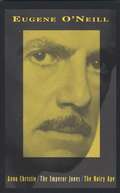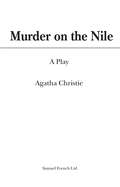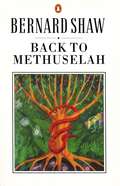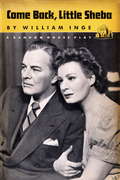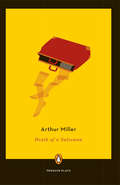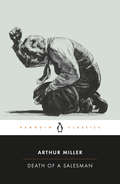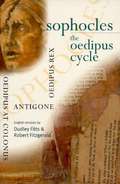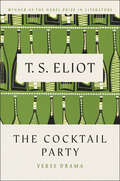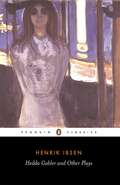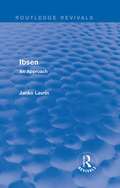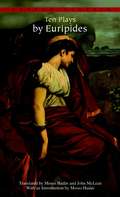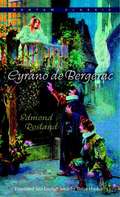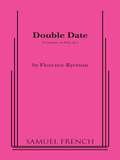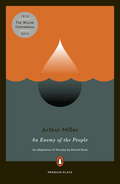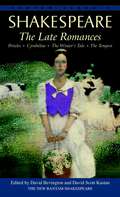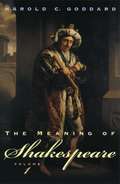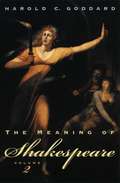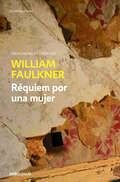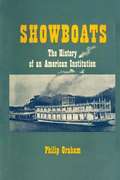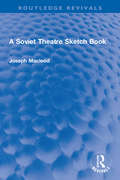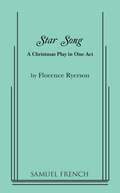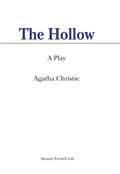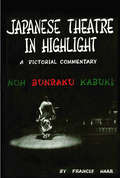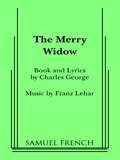- Table View
- List View
The Emperor Jones, Anna Christie, The Hairy Ape
by Eugene O'NeillThree plays by the Nobel Prize winner about people at the base of the social ladder suffering from grief and guilt, as all people can identify with their trials and judgment.
Murder on the Nile
by Agatha ChristieDrama, 8m,5f, Interior Set. Simon Mostyn has recently married Kay Ridgeway, a rich woman, having thrown over his former lover Jacqueline. The couple are on their honeymoon on a paddle steamer on the Nile, accompanied by a bevy of memorable characters. Among those present are Canon Pennefather, Kay's guardian, and Jacqueline, who has been dogging their footsteps all through the honeymoon. During the voyage Jacqueline works herself into a state of hysteria and shoots at Simon, wounding him in the knee. A few moments later Kay is found shot in her bunk. By the time the boat reaches its destination, Canon Pennefather has laid bare an audacious conspiracy and has made sure the criminals shall not go free.
Back to Methuselah
by George Bernard ShawBack to Methuselah (A Metabiological Pentateuch) is a 1921 series of five plays and a preface by George Bernard Shaw. The five plays are:In the Beginning: B.C. 4004 (In the Garden of Eden); The Gospel of the Brothers Barnabas: Present Day; The Thing Happens: A.D. 2170; Tragedy of an Elderly Gentleman: A.D. 3000; As Far as Thought Can Reach: A.D. 31,920 The plays were published with a preface titled The Infidel Half Century, and first performed in 1922 by the New York Theatre Guild at the Garrick Theatre.
Come Back, Little Sheba
by William IngeWilliam Inge's famous story of marital frustration which erupts in violence. Doc and Lola had an indiscreet affair, she became pregnant and, compelled to marry her, he gave up his medical studies, forfeited his future and settled down to a life of quiet desperation with the simple, homey Lola, who lost the child but has remained Doc's steadfast if slatternly wife. Now a chiropractor and recovering alcoholic, Doc's sobriety is tested when Marie, a young college student becomes their boarder bringing new life and long-dormant hostilities to the surface of Doc and Lola's troubled marriage.
Death of a Salesman: Certain Private Conversations In Two Acts And A Requiem (Penguin Plays)
by Arthur MillerThe Pulitzer Prize-winning tragedy of a salesman's deferred American dream Ever since it was first performed in 1949, Death of a Salesman has been recognized as a milestone of the American theater. In the person of Willy Loman, the aging, failing salesman who makes his living riding on a smile and a shoeshine, Arthur Miller redefined the tragic hero as a man whose dreams are at once insupportably vast and dangerously insubstantial. He has given us a figure whose name has become a symbol for a kind of majestic grandiosity--and a play that compresses epic extremes of humor and anguish, promise and loss, between the four walls of an American living room."By common consent, this is one of the finest dramas in the whole range of the American theater." --Brooks Atkinson, The New York Times"So simple, central, and terrible that the run of playwrights would neither care nor dare to attempt it." --Time
Death of a Salesman: Certain Private Conversations in Two Acts and a Requiem (Penguin Twentieth-century Classics Ser.)
by Arthur Miller Christopher W. BigsbyThe Pulitzer Prize-winning tragedy of a salesman's deferred American dream Ever since it was first performed in 1949, Death of a Salesman has been recognized as a milestone of the American theater. In the person of Willy Loman, the aging, failing salesman who makes his living riding on a smile and a shoeshine, Arthur Miller redefined the tragic hero as a man whose dreams are at once insupportably vast and dangerously insubstantial. He has given us a figure whose name has become a symbol for a kind of majestic grandiosity--and a play that compresses epic extremes of humor and anguish, promise and loss, between the four walls of an American living room."By common consent, this is one of the finest dramas in the whole range of the American theater." --Brooks Atkinson, The New York Times"So simple, central, and terrible that the run of playwrights would neither care nor dare to attempt it." --Timeof the finest dramas in the whole range of the American theater." --Brooks Atkinson, The New York Times "So simple, central, and terrible that the run of playwrights would neither care nor dare to attempt it." --Time For more than sixty-five years, Penguin has been the leading publisher of classic literature in the English-speaking world. With more than 1,500 titles, Penguin Classics represents a global bookshelf of the best works throughout history and across genres and disciplines. Readers trust the series to provide authoritative texts enhanced by introductions and notes by distinguished scholars and contemporary authors, as well as up-to-date translations by award-winning translators.
The Plum Tree
by Mary Ellen ChaseThree old ladies are the central characters in this story which deals with a special day in their lives. It was the loving understanding of the matron and a nurse in the home for aged women that converted a potential nightmare into a gala occasion.
Sophocles, the Oedipus Cycle: Oedipus Rex, Oedipus at Colonus, Antigone
by SophoclesEnglish versions of Sophocles' three great tragedies based on the myth of Oedipus, translated for a modern audience by two gifted poets, Dudley Fitts and Robert Fitzgerald. [This text is listed as an example that meets Common Core Standards in English language arts in grades 9-10 at http://www.corestandards.org.]
The Cocktail Party: Verse Drama
by T. S. EliotA comedic play about the universal quest for meaning, written in some of Eliot's "most beautiful poetry" (The New York Times). A sterling example of contemporary theater, The Cocktail Party is a dramatic tour de force from one of our greatest writers to date.
Hedda Gabler and Other Plays
by Henrik IbsenIn these three unforgettably intense plays, Henrik Ibsen explores the problems of personal and social morality that he perceived in the world around him and, in particular, the complex nature of truth. The Pillars of the Community (1877) depicts a corrupt shipowner’s struggle to hide the sins of his past at the expense of another man’s reputation, while in The Wild Duck (1884) an idealist, believing he must tell the truth at any cost, destroys a family by exposing the lie behind his friend’s marriage. And Hedda Gabler (1890) portrays an unhappily married woman who is unable to break free from the conventional life she has created for herself, with tragic results for the entire family.
Ibsen: An Approach (Routledge Revivals #No. 18)
by Janko LavrinThis book, first published in 1950, could best be described as a combination of literary, psychological and social criticism. Considerable space is allotted to the personal inner drama of Ibsen, which provides not only a clue to his art but shows how most of his themes inevitably grew out of the other. The author also explores some of those factors which make Ibsen of interest to the generation that were facing the social and spiritual havoc of the post-war period. This book will be of interest to students of literature and theatre.
Ten Plays by Euripides
by EuripidesThe first playwright of democracy, Euripides wrote with enduring insight and biting satire about social and political problems of Athenian life. In contrast to his contemporaries, he brought an exciting--and, to the Greeks, a stunning--realism to the "pure and noble form" of tragedy. For the first time in history, heroes and heroines on the stage were not idealized: as Sophocles himself said, Euripides shows people not as they ought to be, but as they actually are.
Cyrano de Bergerac: A Heroic Comedy in Five Acts
by Edmond Rostand Brian HookerThis is Edmond Rostand's immortal play in which chivalry and wit, bravery and love are forever captured in the timeless spirit of romance. Set in Louis XIII's reign, it is the moving and exciting drama of one of the finest swordsmen in France, gallant soldier, brilliant wit, tragic poet-lover with the face of a clown. Rostand's extraordinary lyric powers gave birth to a universal hero--Cyrano De Bergerac--and ensured his own reputation as author of one of the best-loved plays in the literature of the stage. This translation, by the American poet Brian Hooker, is nearly as famous as the original play itself, and is generally considered to be one of the finest English verse translations ever written.
Double Date
by Florence RyersonComedy / 3m, 4f / Interior / The girls plan to outsmart the boys, but Uncle Clay and the boys learn what they are up to and give them a run for their money. The girls, who are from south of the Mason Dixon line, are not used to such discipline. A human and amusing play.
An Enemy of the People
by Henrik Ibsen Arthur Miller<P>When Dr. Stockmann discovers that the water in the small Norwegian town in which he is the resident physician has been contaminated, he does what any responsible citizen would do: reports it to the authorities. <P>But Stockmann's good deed has the potential to ruin the town's reputation as a popular spa destination, and instead of being hailed as a hero, Stockmann is labeled an enemy of the people. <P>Arthur Miller's adaptation of Henrik Ibsen's classic drama is a classic in itself, a penetrating exploration of what happens when the truth comes up against the will of the majority. This edition includes Arthur Miller's preface and an introduction by John Guare.
The Late Romances: Pericles, Cymbeline, The Winter's Tale, The Tempest
by William ShakespeareThe first of Shakespeare's late romances moves spectacularly from one dramatic period to another as the hero, Pericles, sails off to adventure and love, and experiences what for him is a miracle. Cymbeline: A favorite romantic drama, this play of a wife unjustly accused of faithlessness moves from a world of intrigue and slander to one of reconciliation and forgiveness, and contains two of Shakespeare's most poignantly beautiful songs. The Winter's Tale: From a darkly melodramatic beginning to a joyous pastoral ending, this romance of a jealous king and his long-suffering queen is superb entertainment, with revelations, plot twists, and a final compelling theatrical moment of discovery. The Tempest: This tale of the exiled Duke of Milan, marooned on an enchanted island, is so richly filled with music and magic, romance and comedy, that its theme of love and reconciliation offers a splendid feast for the senses and the heart.
The Meaning Of Shakespeare Volume 1
by Harold C. GoddardIn two magnificent and authoritative volumes, Harold C. Goddard takes readers on a tour through the works of William Shakespeare, celebrating his incomparable plays and unsurpassed literary genius.
The Meaning of Shakespeare (Volume II)
by Harold C. GoddardIn two magnificent and authoritative volumes, Harold C. Goddard takes readers on a tour through the works of William Shakespeare, celebrating his incomparable plays and unsurpassed literary genius.
Réquiem por una mujer
by William FaulknerUna de las novelas capitales de Faulkner sobre la culpa y el destino, inspiradora de la adaptación teatral de Albert Camus.En esta novela que retoma los personajes de Santuario, el matrimonio de Temple Drake y Gowan Stevens sufre una pérdida intolerable: su hija pequeña es asesinada por su niñera, a la que luego se condena a muerte. Sin embargo, poco antes de que se cumpla la sentencia Temple buscará interceder por la muchacha. Y es que no solo está en juego la administración de la justicia, sino también la culpa histórica de toda una sociedad fundada en tierra hostil y manchada por la violencia. Contada por turnos en una prosa desbordante y como obra de teatro, Réquiem por una mujer es una inquietante exploración del impacto del pasado en el presente.
Showboats: The History of an American Institution
by Philip GrahamThis book is a delightful and authoritative record of America''s showboats from the first one, launched in 1831, to the last, ultimately tied up at a St. Louis dock. It is also a record of the men and women who built and loved these floating theaters, of those who performed on their stages, and of the thousands who sat in their auditoriums. And, lastly, it is a record of a genuine folk institution, as American as catfish, which for more than a century did much to relieve the social and cultural starvation of our vast river frontier. For these showboats brought their rich cargoes of entertainment--genuine laughter, a glimpse of other worlds, a respite from the grinding hardship of the present, emotional relaxation--to valley farmers, isolated factory workers and miners, and backwoodsmen who otherwise would have lacked all such opportunities. To the more privileged, the showboats brought pleasant reminder of a half-forgotten culture. They penetrated regions where churches and school had not gone, and where land theaters were for generations to be impossible. Like circuit preachers, they carried their message to the outer fringes of American civilization. In spite of many faults, it was a good message. The frontier had created this institution to fill a genuine need, and it lasted only until other and better means of civilizing these regions could reach them--good roads, automobiles, motion pictures, schools, churches, newspapers, and theaters. But although the showboats have passed into history, they have left a rich legacy. As long as the Mississippi flows into the Gulf, their story will fire the imagination of Americans. Showboating has become so legendary that few Americans know what this unique institution was really like. In Showboats, at long last, the true story emerges. It differs in many important respects from the motion picture and fictional versions to which Americans are accustomed, but it is not a whit the less glamorous. Philip Graham has told his story with imagination, genuine insight, and complete devotion to facts. No one who is interested in America''s past should fail to read it. This book is a delightful and authoritative record of America''s showboats from the first one, launched in 1831, to the last, ultimately tied up at a St. Louis dock. It is also a record of the men and women who built and loved these floating theaters, of those who performed on their stages, and of the thousands who sat in their auditoriums. And, lastly, it is a record of a genuine folk institution, as American as catfish, which for more than a century did much to relieve the social and cultural starvation of our vast river frontier. For these showboats brought their rich cargoes of entertainment - genuine laughter, a glimpse of other worlds, a respite from the grinding hardship of the present, emotional relaxation - to valley farmers, isolated factory workers and miners, and backwoodsmen who otherwise would have lacked all such opportunities. To the more privileged, the showboats brought pleasant reminder of a half-forgotten culture. They penetrated regions where churches and school had not gone, and where land theaters were for generations to be impossible. Like circuit preachers, they carried their message to the outer fringes of American civilization. In spite of many faults, it was a good message. The frontier had created this institution to fill a genuine need, and it lasted only until other and better means of civilizing these regions could reach them - good roads, automobiles, motion pictures, schools, churches, newspapers, and theaters. But although the showboats have passed into history, they have left a rich legacy. As long as the Mississippi flows into the Gulf, their story will fire the imagination of Americans. Showboating has become so legendary that few Americans know what this unique institution was really like. In Showboats, at long last, the true story emerges. It differs in many important respects from the motion picture and fictional versions to which Americans are accustome...
A Soviet Theatre Sketch Book (Routledge Revivals)
by Joseph MacleodFirst Published in 1951, A Soviet Theatre Sketch Book presents Joseph Macleod’s take on Russian Theatre in a semi-fictional way to show the effect of the productions upon different audiences. By using his pen as an artist uses his pencil, he gives, for the first time, an account of theatre audiences as composed of individual human beings and is able to paint the scenes vividly without neglecting the technical methods of the Soviet stage. By supple use of the sketch- book form, theatres, theatre-schools, actors, and actresses including some no longer appearing are painted into an all-over view of Russian and Ukrainian post-war life. In this book the author writes less immediately about the Soviet Union and does not depend on topicality or stop press news. Joseph Macleod and his wife visited the Soviet Union as the guests of the Russian and Ukrainian Societies for Cultural Relations with Foreign Countries. This book will be of interest to scholars and researchers of theatre, history of theatre, and performance studies.
Star Song
by Florence RyersonChristmas Play / 4m, 5f / The scene is an inn on the way to Bethlehem on the night of Christ's birth. The inn's occupants are too busy with their squabbles and personal worries to sense the great, holy event occurring in a stable nearby. Only a slave and a little lame girl are prepared for this momentous occasion. It is a very dramatic, touching play. A good opportunity for singing clubs or choirs, but the music may be minimal if desired.
The Hollow
by Agatha ChristieDrama / 6m,6f / Interior Set. An unhappy game of romantic follow-the-leader explodes into murder one weekend at The Hollow, home of Sir Henry and Lucy Angkatell. Dr. Cristow is at the center of the trouble when his mistress Henrietta, ex-mistress Veronica, and wife Gerda, simultaneously arrive at The Hollow. Also visiting are Edward (who is in love with Henrietta) and Midge (who loves Edward). Veronica ardently desires to marry Cristow and succeeds in reopening their affair but is unable to get him to divorce his wife. Veronica unwisely states that if she cannot have him, no one shall. Within five minutes Cristow is dead. Nearly everyone has a motive and most had the opportunity. Enter Inspector Colquhoun and Sergeant Penny to solve the crime.
Japanese Theatre in Highlight: A Pictorial Commentary
by Francis Haar Earle Ernst Faubion BowersWords cannot explain to an outsider the sight and feel of the Japanese stage. And definitions and descriptions do not convey an exact image to people brought up on a concept of the theatre that differs so greatly from the Japanese as ours. In seeing something foreign, too, our eyes must be guided carefully, so that we know what we are seeing and how to look at it profitably. All of us are to be grateful for this book, because now, without leaving our contries, or for that matter our armchairs, we can peer at leisure into expertly selected, edited and glossed highlights of the three great classical theatre arts of Japan-Noh, Bunraku and Kabuki. The Fifty-four ensuing photgraphs, with their textual commentary, are the equivalent, in my mind, of fifty-four choice seats at some of the best performances in modern Japan and intimate visits backstage.
Merry Widow
by Charles GeorgeOperetta \ 6 m, 12 f w/flexible chorus. \ Int. \ All the world famous songs have been retained, embellished with new lyrics that critics believe to be the best words ever to the Lehar score. There's a new story of a dashing European prince and his romance with a beautiful American widow. The comedy is clever and wholesome and is not difficult to cast or stage.
